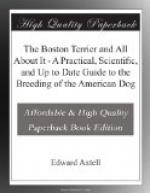non-observance of which will inevitably lead to shipwreck.
Better by far turn one’s energies in attempting
to square the circle, or produce a strain of frogs
covered with feathers, than attempt to raise Boston
terriers without due attention being given to those
physiological laws which experience has proven correct.
The first law is that “Like produces like,”
although, as previously stated in the case of this
breed, more than in any other known to the writer,
many exceptions present themselves, even when the
utmost care has been exercised, still the maxim holds
good in the main. The second law is that of Heredity,
too often paid inadequate attention to, but which
demands constant and unremitting apprehension, as
it modifies the first law in many ways. It may
be briefly described as the biological law by which
the general characteristics of living creatures are
repeated in their descendants. Practically every
one has noticed its workings in the human family,
how many children bear a stronger resemblance to their
grandparents, uncles, cousins,
etc., than to their
parents, and in the lower order of animals, and it
seems to me in the Bostons especially, this tendency
to atavism, or throwing back to some ancestor, in
many cases quite remote, is very pronounced, hence
the necessity of a good general knowledge of the pedigree
and family history of the dogs the breeder selects
for his foundation stock. A kennel cannot be
built in a day; it takes time, money, perseverance,
and a strict attention to detail to insure success.
“Breed to the best,” is a golden rule,
but this applies not only to the animals themselves,
but also in a far greater measure to the good general
qualities possessed by their ancestry. Far more
pregnant with good results would be the mating of
two good all-round specimens, lacking to a considerable
extent show points, but the products of two families
known for their general excellence for several generations,
than the offspring would be of two noted prize winners
of uncertain ancestry, neither of which possessed
the inherent quality of being able to reproduce themselves.
It will be noted that very few first prize winners
had prize winning sires and dams. The noted stud
dogs of the past, “Buster,” “Sullivan’s
Punch,” “Cracksman,” “Hickey’s
Teddy IV.” and many others were not in themselves
noted winners, and the same statement may be made of
the dams of many of the prize winning dogs, but they
possessed in themselves and their ancestry that “hall
mark” of quality which appeared in a pronounced
form in their offspring. Experience has shown
that first class qualities must exist for several
generations in order to render their perpetuation
highly probable. The converse of this is equally
true, that any bad qualities bred for the same length
of time are quite as hard to eliminate. If the
dog or bitch possesses weak points, be sure to breed
to dogs coming from families that are noted for their
corresponding strong points. In this case the




